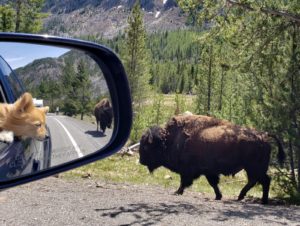
Day 24 (Monday, May 24, 2021)
It’s another cold morning as we pack up to head up north, leaving Grand Teton NP for Yellowstone NP, which will be our destination for the next 4 days.
But GTNP won’t let us leave without a bang! Just near Colter Bay Village, traffic slows to a crawl and based on the activity on the sides of the road, we know something BIG is out there … while we can’t stop or pull over on a packed street with the trailer in tow, the guy in front of is all but stopping in the middle of the road, allowing for us to get a great view of what’s about a couple hundred yards to the west: a big brown bear (to be correct: a black bear)! Woo-hoo! Timing is everything, and this morning it is perfect for us and Kirk’s 400mm lens is doing its job – giving us a great shot of the bear!
Even more excited, we head up along Jackson Lake, leave Grand Teton and shortly after enter Yellowstone National Park via the South Entrance. As we drive along the Lewis River, we can easily see the new tree growth that followed the 1988 fires which had devastated much of the park’s lodgepole pine forests. During my last visit some 15+ years ago, this was all still looking a lot more dire, but today shows spring green everywhere we look. Just before Lewis Lake we cross the approximate border line of the Caldera … from the last eruption 640K years ago. Not only are we headed north, but also up in elevation, and well before we hit the Continental Divide at 7,988 feet we are driving through the falling snow! What date is it again? Oh, well, the Yellowstone season only just started last week … so I guess this was sort of to be expected.
As we approach West Thumb Geyser Basin on the southeast edge (west thumb) of Yellowstone Lake at 7,733 ft elevation the snow has become a steady buddy for our visit, but can’t keep us from checking out the various steaming geysers, pools, cones, hot springs, mud pots and more. West Thumb’s shoreline has suspiciously crater-like contours. Its underwater profile is dramatically deeper than the rest of Yellowstone Lake. Only a massive explosion could have formed West Thumb. Though the blowout occurred 125K years ago, the area is still thermally active.
As we continue on, we cross the Continental Divide once more (now at 8,262 ft elevation), and snow is not only accumulating on the road but also on the trailer. It’s a first for the Airstream … Soon enough we reach the next highlight: Upper Geyser Basin, home of Old Faithful! As we walk up to the geyser, the visitor information sign alerts us that the next eruption is predicted for just about 30 minutes from now. Great timing as Old Faithful puts its show on approx. every 50-120 minutes. With J.T. in the trailer, we take a walk around the geyser area and pick our spot on the north/east side of it, away from the large number of spectators already accumulating for the show. The sun is starting to make an appearance as well, and while the short break in the clouds is much appreciated, the gusty wind drives the steam – and during the eruption also the water’s mist – right towards us, for a free sprinkling shower.
As we still have to make our way to West Yellowstone and check into our campground there, we soon head onwards along the Firehole River towards Madison, bypassing the various geyser basins for another day’s sights. On our way west along the Madison River, traffic slows again, this time to let a herd of bison cross the road, meander along the road and show off the full beauty of the park.
Checking in at the KOA West Yellowstone and setting up, it’s cold and damp again … good thing for our heater getting the little trailer warmed up in no time.
Day 25 (Tuesday, May 25, 2021)
Time to head back into the park – and back into Wyoming! Forgot to mention, but just a couple miles before the park’s west exit, we had crossed from WY into Montana, and hence now we’re going back to WY for the day.
Today’s destination is the north and northeast of the park – starting with a stop at Gibbon Falls, along the Gibbon River between Madison and Norris. We skip the various sights on this stretch of the road for the next day, and head on north along the Gardiner River towards Mammoth Hot Springs. Without the trailer, we’re able to take the Upper Terrace Drive through the hot springs, park and take a stroll through the upper and lower terraces areas. From the overlook, the views include an almost-aerial look at historic Fort Yellowstone, which makes up most of the “town” part of this area, as well as a great look at the Main Terrace, Mound Terrace and Cleopatra Terrace in the lower part.
We skip the drive to the north entrance (to Gardiner), as we have a bigger target in mind: Lamar Valley to the east, where bears and wolves are frequently spotted. The Blacktail Plateau Drive is still closed (too early in the season), but even the “regular” route offers spectacular views over the northern range, mountains in the (not so far) distance and Yellowstone River in the distance. As we make a quick stop at the Petrified Tree near Tower-Roosevelt, we come face to face with a bison hanging out in the parking area. Never ceases to amaze …
As we cross the Yellowstone River to follow the Lamar River east through the Lamar Valley, we see plenty more bison. We do come across one spot where plenty of people are still watching with their scopes and big-lens cameras – for wolves, as we learn, who had been out here until about 15 minutes ago. Bummer … too late for this show. We continue on east, then along the Soda Butte Creek towards the Northeast Entrance. Just a couple of miles before the park boundary, we get lucky – a moose is grazing near the road, by a picnic area. We stop to check it out, and Kirk gets some great photos. After leaving and re-entering the park, we get a little worried about what other wildlife we might encounter, as the sun starts to set while it’s getting late. Bison, bison, bison … doesn’t get old. But just a few miles after Tower junction, we strike gold: bears! A momma bear wither two cubs are playing around some tree trunks in the distance. Far enough to be safe (for us) to be out of the car, but close enough to get a clear view through our binoculars and Kirk’s camera view finder – for some nice shots!
It starts raining and gets dark as we make our way back west. A few more bison – and great views of the steam clouds rising up from the various geysers, almost shining brightly in the moon light – entertain us as we make our way back to camp.
Day 26 (Wednesday, May 26, 2021)
Day 3 for our Yellowstone visit will focus on the various geysers we missed the previous day and take us east to Canyon. But first – the highlights between Madison and Norris. We start with Beryl Spring and the Artists Paintpots before heading to the Norris Geyser Basin. While the Steamboat Geyser is noted as the highlight, it’s only one of many “sights to see” in this area. Norris Geyser Basin is Yellowstone’s most dynamic – the hottest, most acidic, and most dynamic – geyser basin. It is part of the world’s largest active volcanoes.
When Steamboat Geyser erupts, it can rocket a column of scalding water 300 feet into the air – two or three times the average height of Old Faithful. Steam ca roar for up to 24 hours after. Odds of witnessing this eruption however are against us visitors, as they can occur from 4 days to 50 years apart! I’m not quite lucky enough to witness a big eruption today, but smaller spouts of water do shoot up while I’m watching, and I take that as a win in my book!
Just below the geyser is Cistern Spring, with its various colors created by a variety of living things in it, where the spring’s brown, orange and green colors are representing different species of algae and bacteria, each requiring a different temperature environment.
We head on further west, to Canyon Village, home to the “Grand Canyon of the Yellowstone”. The canyon varies from 800 to 1,200 feet in depth and from 1,500 to 4,000 feet in width. Its length is about 24 miles, of which the upper 2.5 miles is the most colorful section. Steam vents and geysers are still at work in the canyon walls, and hot springs activity has continued through the ages, altering the lava rock to produce the lovely colors which hare largely due to varied iron compounds.
After checking out the canyon as well as the upper and lower falls from both the North Rim and the South Rim, we head south along the Yellowstone River towards Lake Village, on the shores of Yellowstone Lake. But before reaching the lake, we stop at the Sulphur Caldron and the Mud Volcano, both worth a quick stop along the way. The weather has been all over the place today, and while we seem to have a dry break for our walk around the mud volcanoes, we do get some rain coming down just after our meet & greet with the bison along the walkway (safety distance maintained!).
As we round off today’s tour skipping right past Old Faithful (it’s getting late), we do stop at the Black Sand Basin within the Upper Geyser Basin, as the setting sun and the light are just right. Black obsidian (volcanic glass) “sand” gives this geyser basin its name. Oranges, greens, and other colors in and around the hot springs come from Thermophiles (heat-loving micro-organisms).
Sunset along the Madison River makes for more great photo opportunities as we are heading out of the park, as do the repeated bison sightings along (and on) the road.
Day 27 (Thursday, May 27, 2021)
Today is already our last day for Yellowstone … Having four days seemed enough, but we are quickly running out of time with so much more to see! On our list for today are the geyser basins we’ve skipped over twice now – and after a welcome by the bison and a scenic drive through the Firehole Canyon (including a stop at the falls), we reach the Lower Geyser Basin including the Fountain Paint Pot. Here, the path takes us through on of the most complex and dynamic hydrothermal areas in Yellowstone, past geysers, hot springs, fumaroles, and mudpots. The geysers here exhibit a variety of eruption patterns and intervals, including changes throughout the year.
Next up is the Midway Geyser Basin, with its highlight being the Grand Prismatic Spring – Yellowstone’s largest hot spring. It is the largest and one most brilliant of the park’s many colorful hot springs. Its massive expanse stretches approx. 200 feet across. The high temperature of its water (160 F) ensures that the spring is often cloaked in steam.
Within the rainbow of orange, brown, and red colors, some microorganisms live in communities of thick mats. Like miniature forests, these mats have a vertical structure and stratified functions. Microbes that live on or near the top of the mat (similar to a forest canopy) use sunlight to perform photosynthesis, which fuels the mat community. Organisms living deeper in the mat (similar to a forest understory) derive energy from chemicals produced by the surface microbes. They perform other vital functions such as decomposition and recycling nutrients to the mat’s “canopy” just like their counterparts in a forest. All of these organisms create an ecosystem in the expanse of a few inches.
Last but not least (before returning to Old Faithful) is Biscuit Basin. This thermal basin is particularly volatile, unpredictable. On Aug 17, 1959, a 7.5 earthquake had its epicenter just a few miles to the northwest. Four days later, Sapphire Pool began to erupt violently, blowing away the large rock biscuits around the crater, the mineral formations which the basin was names for.
We park just outside historic Old Faithful Inn (hotel), which I really wanted to visit to check out the lobby. However, being too early in the season, I’m a week ahead of opening date. Instead, we head up to the Old Faithful geyser area, and learn that the next eruption is about an hour out. With the sun shining and temps nice for a change, we hang out on our front row bench and wait. Just before 6pm, we watch Castle Geyser erupt in the distance. Quite the treat, as this one is a lot less frequent (approx. 14 hours between eruptions), but the long duration and high fountain of water shooting up makes it a must see. Finally, just a few minutes “late”, Old Faithful erupts right in front of us. While Kirk videos the whole thing (it lasts about 6 minutes), I snap pictures as the steam (and mist) is blown away from us, unlike earlier this week.
A few more bison encounters as well as another beautiful sunset along the Madison River round off our visit to Yellowstone. Definitely a place to come back to and spend some more time …

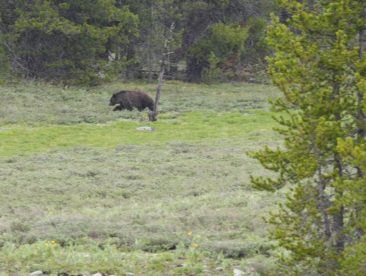
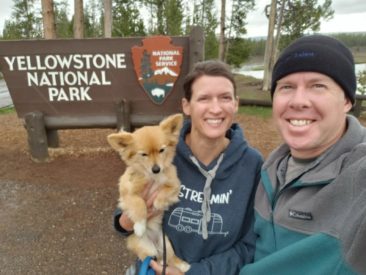
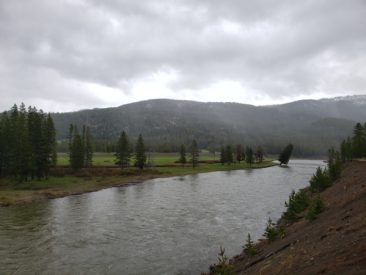
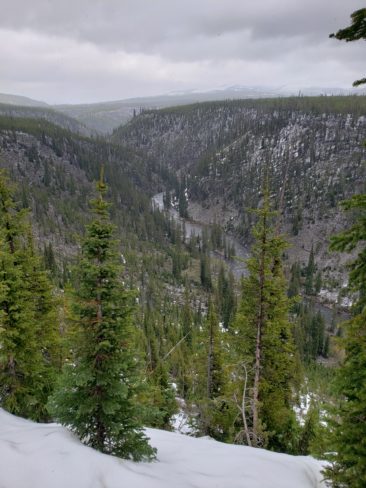





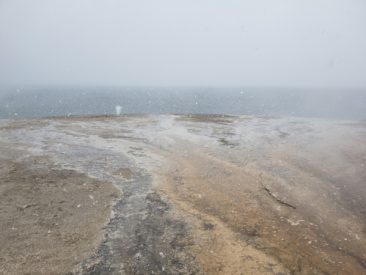
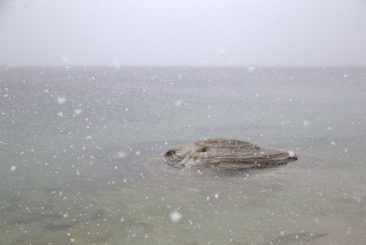
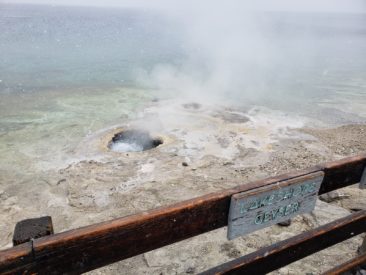


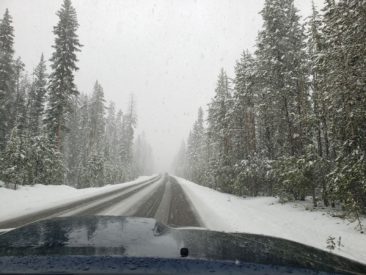

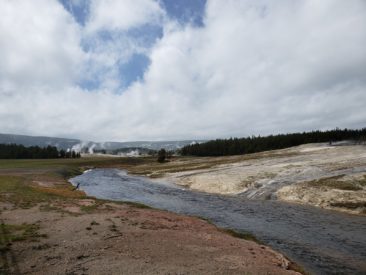
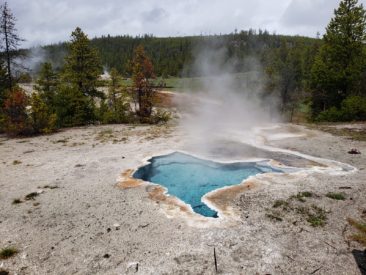
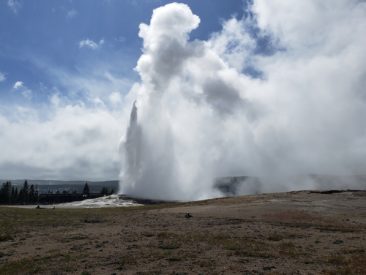

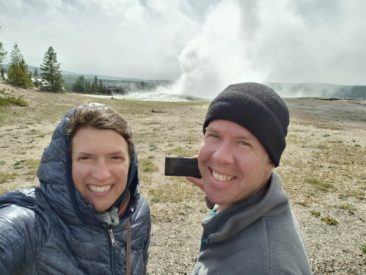
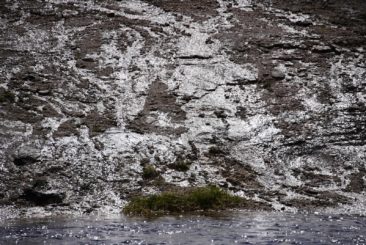
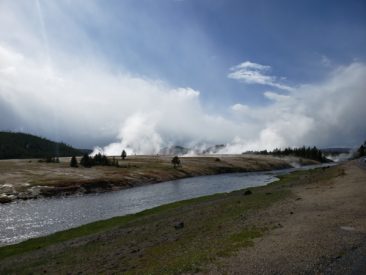
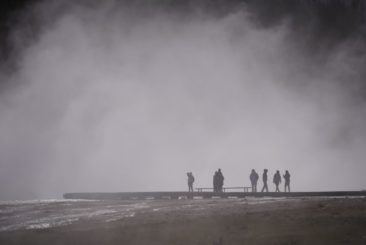

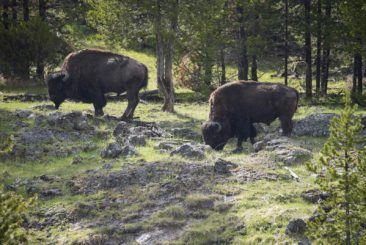
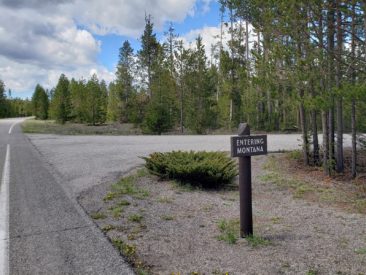
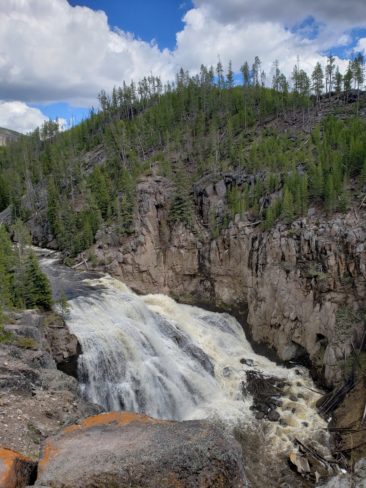

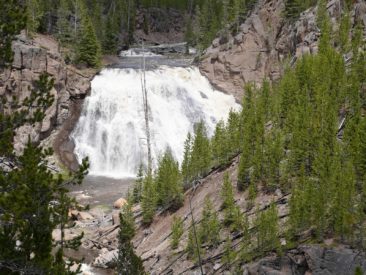


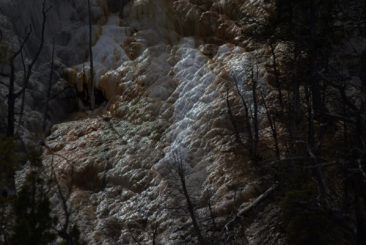
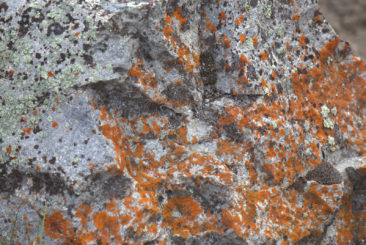
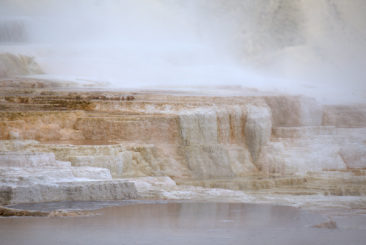
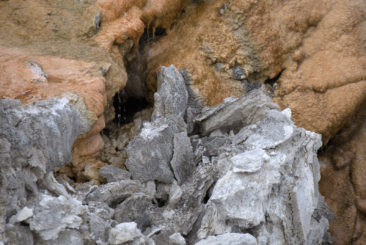
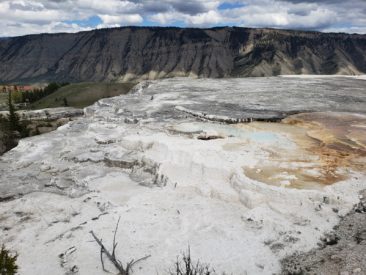
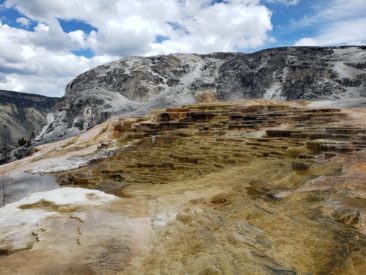


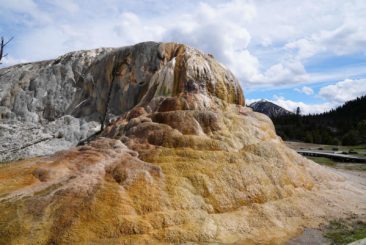
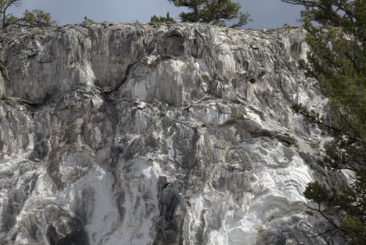
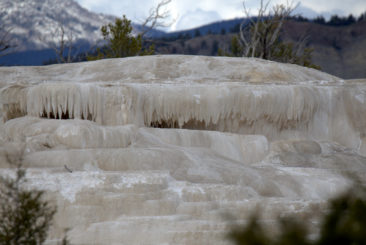
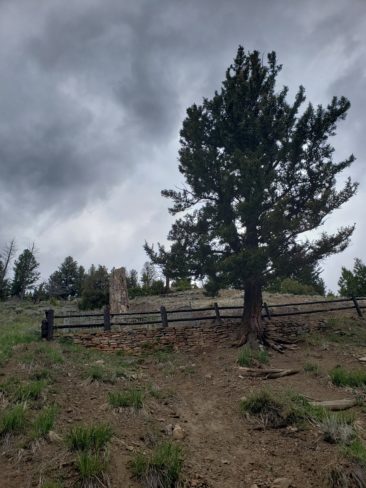

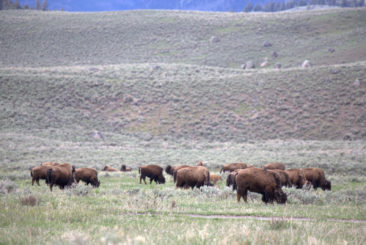


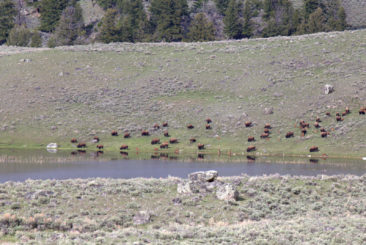
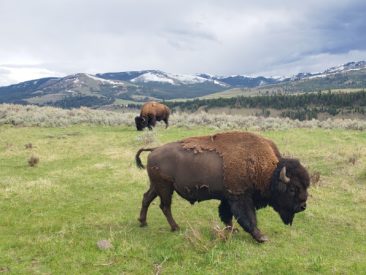
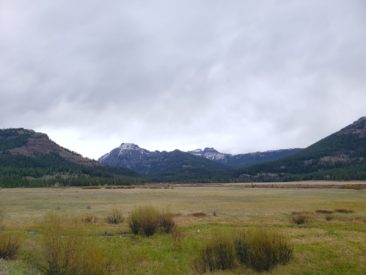
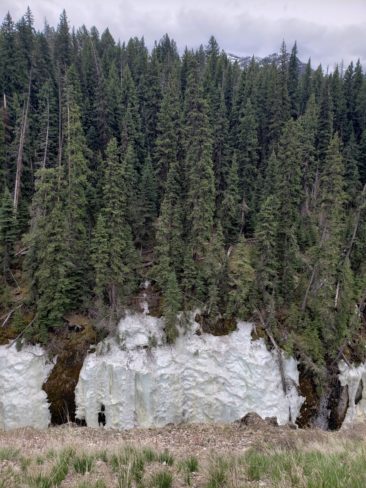





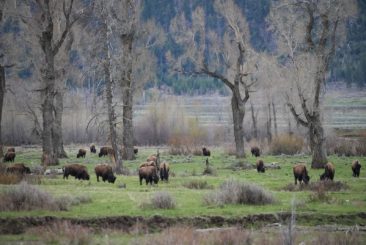
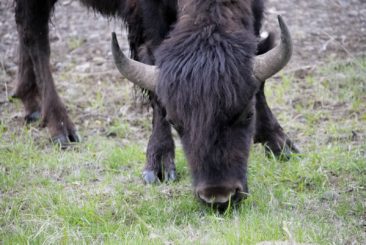
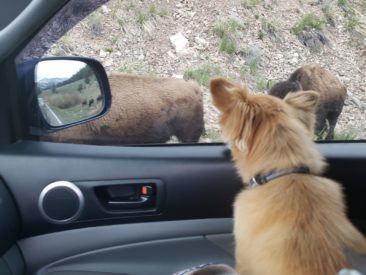
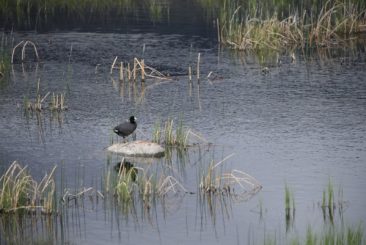
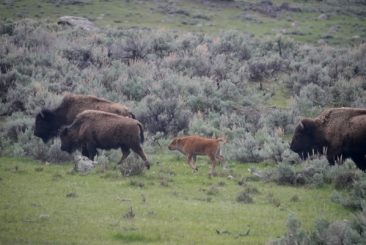
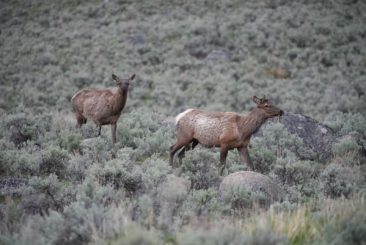
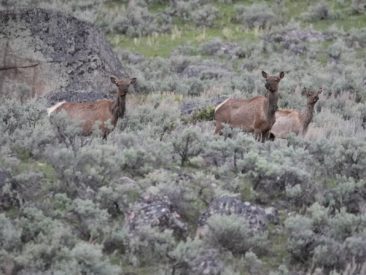
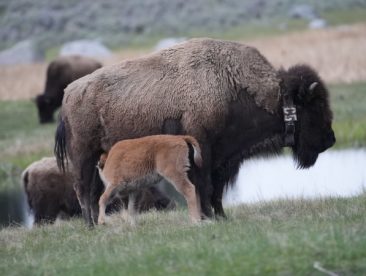
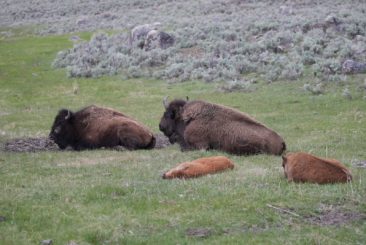

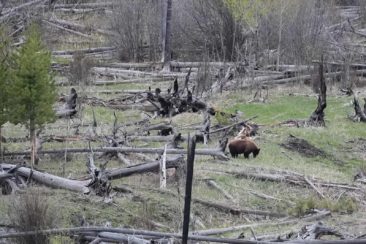
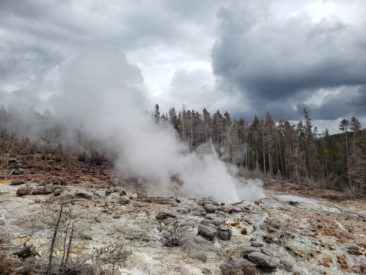
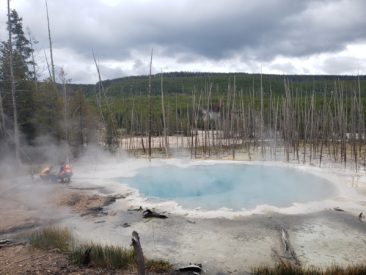
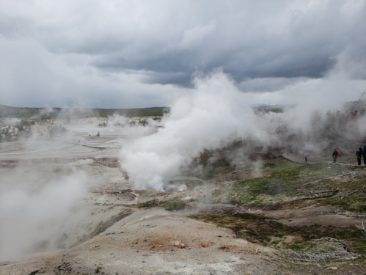
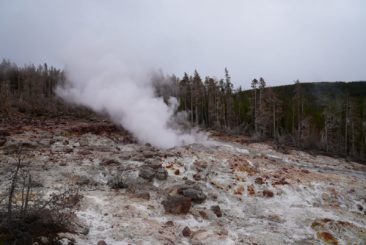
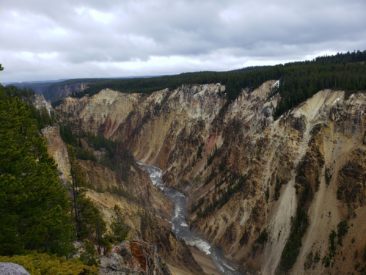

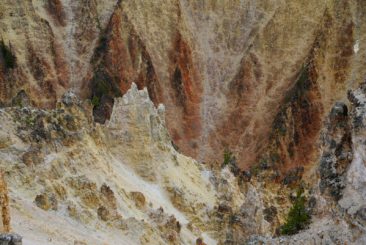
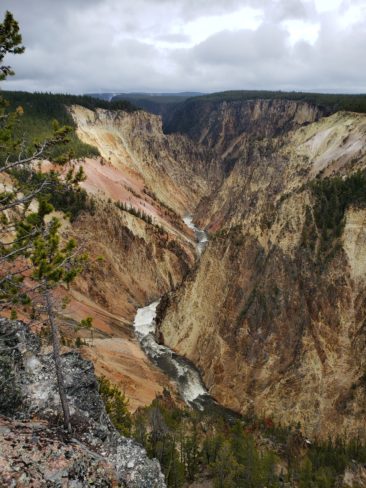

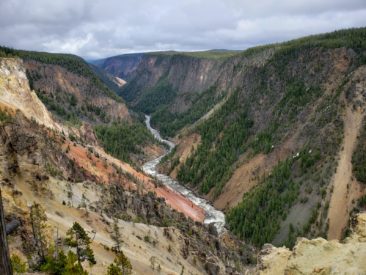
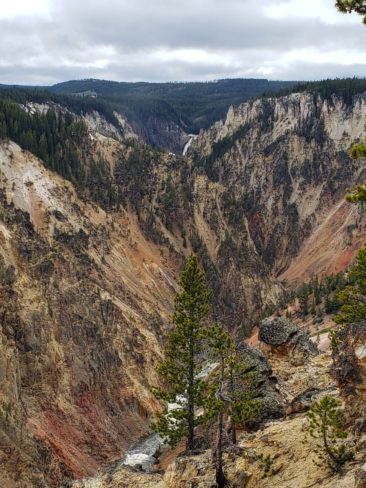
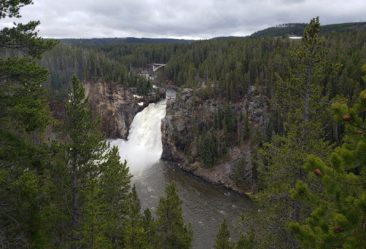
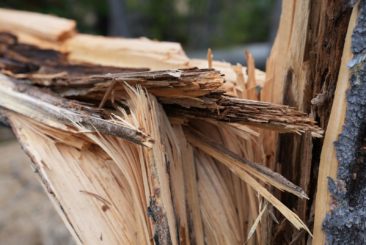
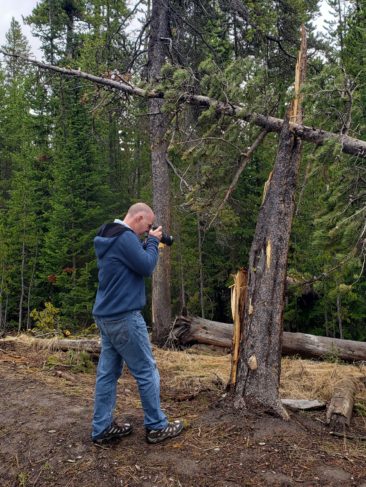
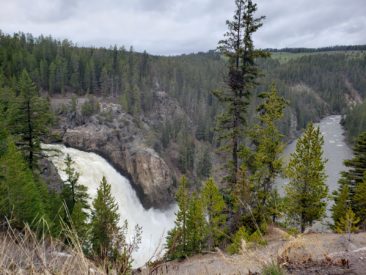
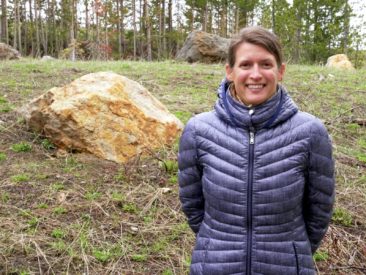
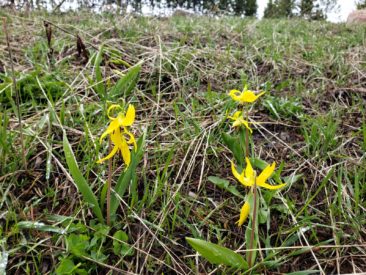
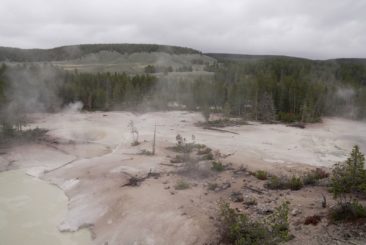


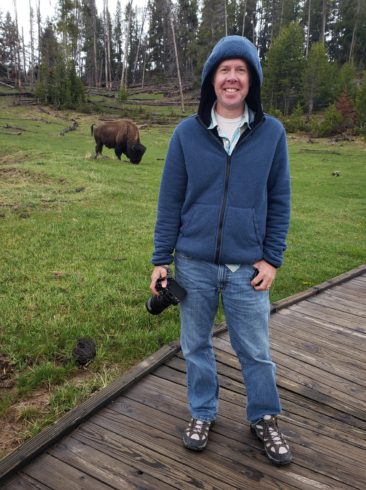

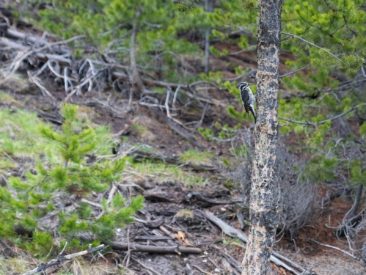
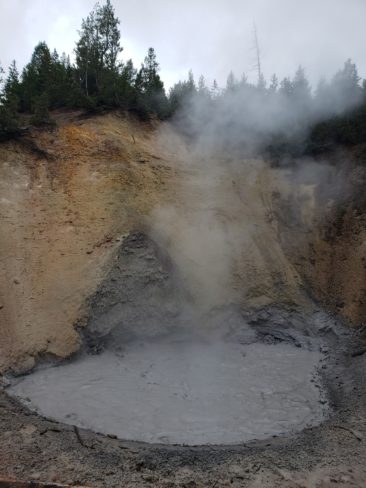

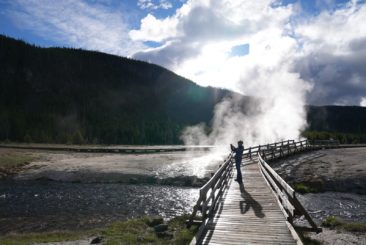
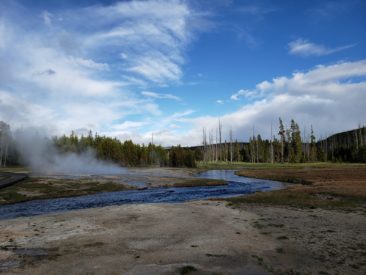
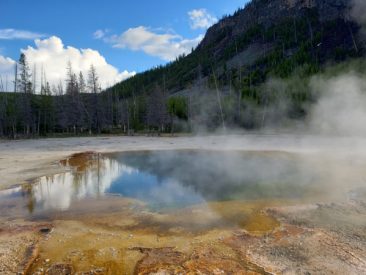
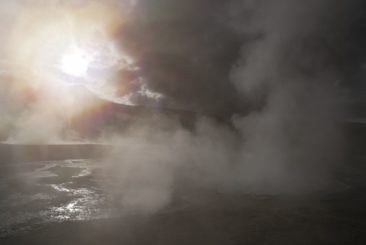
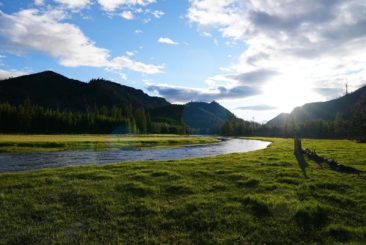
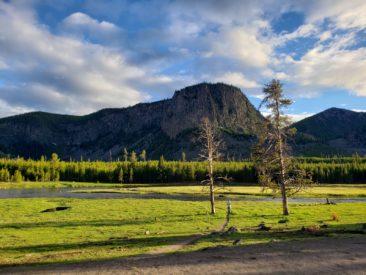
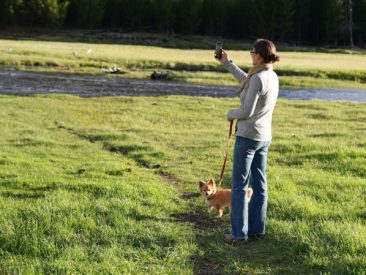


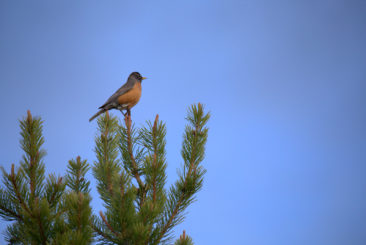
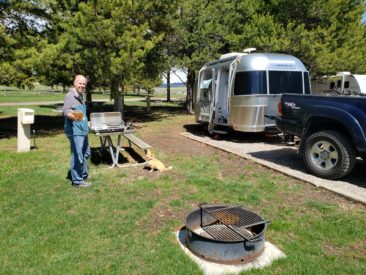

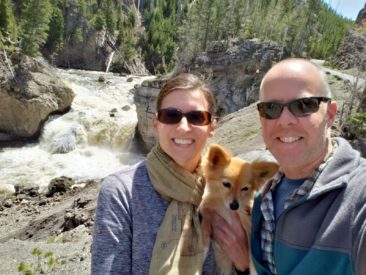

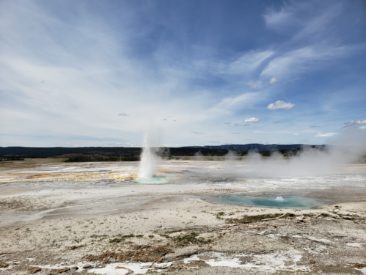
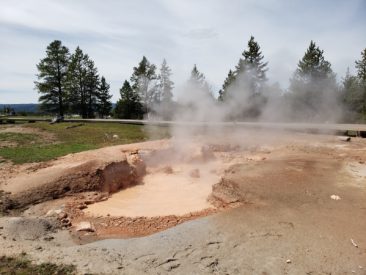
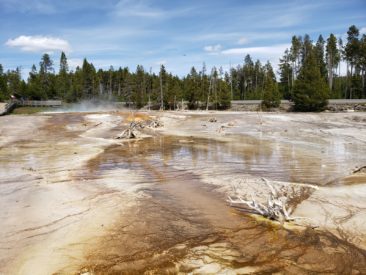
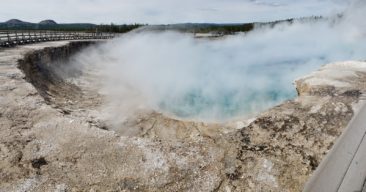
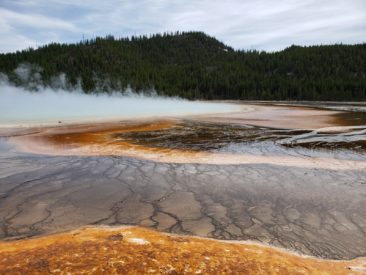
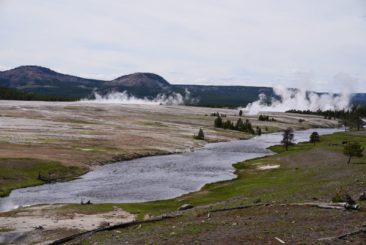


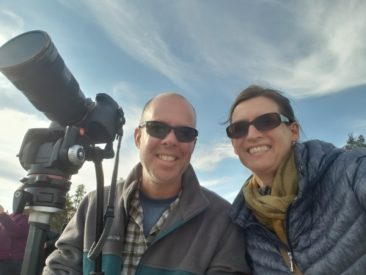


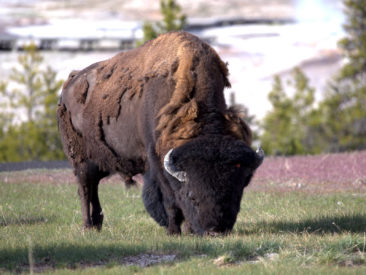

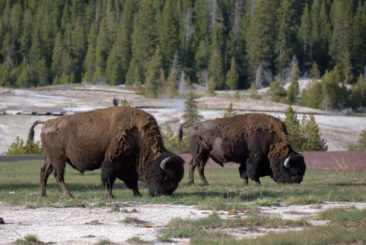

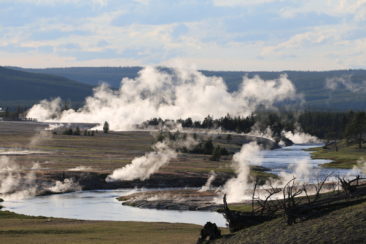
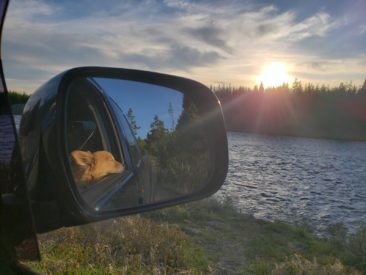

Sabine
Simply stunning
Rita Ann
Love following your journey. Brrrr. And. Awe.